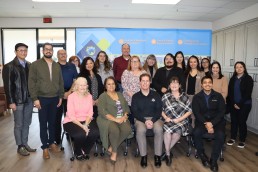California Violence Intervention & Prevention
First Ever — Health & Safety Plan
for Jurupa Valley
California Violence Intervention and Prevention (CalVIP) works to improve public health and safety by supporting effective violence reduction initiatives in communities that are disproportionately impacted by violence.
Join Our Town Hall
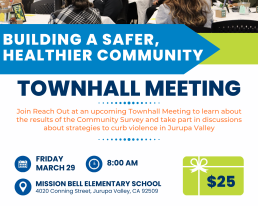
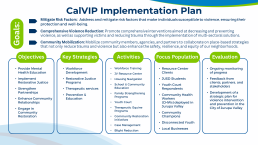
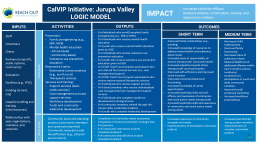
CalVIP Objectives:
- Provide Mental Health Education
- Implement Restorative Justice
- Strengthen Partnerships
- Enhance Community Relations
- Engage in Community Restoration
The Transformative Role of Community Health Workers
Bridging Gaps in Healthcare Access
Community Health Workers (CHWs) are increasingly essential in providing comprehensive healthcare support in various communities. Their work spans educational outreach, healthcare advocacy, and specialized healthcare programs.
Reach Out trains and employs CHWs throughout the Inland Empire, and hopes to see these critical healthcare workers utilized more widely across the potential spectrum of applications. This post will consider:
- Who are community health workers?
- The critical importance of trust and cultural literacy for CHWs
- The spectrum of a CHWs work
- Who is a good fit and how is a CHW trained?
Who Are Community Health Workers?
According to Dr. Shermineh Davari, Director of Reach Out’s Inland Health Profession Consortium Department (IHPC), CHWs are individuals trained to assist their communities with a variety of healthcare issues. Dr. Davari's department, for instance, runs various programs such as work-based learning and mental health advocacy, with a special focus on Community Health Workers. “The goal is to find gaps and remove barriers to provide more equitable access to resources and services within our communities," she explains.
Mayra Mixco, a physician trained in El Salvador, is a program manager at Reach Out focused on the CHW initiatives there. “Community Health Workers inform communities about healthcare issues, help schedule various appointments, and focus on culturally appropriate outreach. They seek to connect as trusted community members, working in community spaces, including churches, consulates, and schools.”
Trust Comes with Cultural Literacy for CHWs
The cornerstone of effective healthcare provision by CHWs is trust. These workers share a cultural, linguistic, and social background with the communities they serve, which makes their role exceptionally vital. From providing healthcare education to serving as navigators and advocates, the CHW’s responsibilities are diverse. After specialized training, they are equipped to provide more equitable and inclusive services.
This trust allows CHWs to battle common myths and misconceptions about conditions and treatments that may exist in certain cultural communities. Mayra quoted a situation where she discovered that some community members believe that the diabetes treatment medication would make them go blind – when that is a risk of the disease itself. “The CHW knows our community, knows our culture, what we believe in, and what we do not believe in. They can actually come, get comfortable, and educate during a casual conversation, dispelling myths and misconceptions as they help access resources.”
The Spectrum of Work: What Do CHWs Do?
The scope of a Community Health Worker's focus can be expansive, varying by setting, healthcare system, and community. They might assist a diabetic patient in understanding their medication and monitoring blood sugar levels. They may also aid in appointment scheduling and running regular tests.
CHWs go by various names, including health navigators and case managers. No matter the title, their focus remains on providing personalized, culturally sensitive healthcare support.
Who is a Good Fit for a Role as a CHW?
Typically, CHWs begin as individuals already recognized by their communities as trustworthy and proactive—people identified as "doers," "seekers," or "advocates." Mayra emphasizes that those who undergo training to become CHWs already possess a foundational skill set, which gets refined and directed through the program.
Reach Out's Training Programs
Reach Out (and many other organizations) actively train CHWs. We offer an 80-hour training program that not only covers health-related topics but also includes development of interpersonal and communication skills. Following the training, CHWs must complete 40 hours of field experience to get hands-on practice in the community, something Reach Out helps to facilitate.
New Funding Opportunities and Specialization
Funding is now being directed towards expanding the focus of CHWs to areas such as substance misuse. Dr. Davari and Mayra both emphasize that CHWs could play an essential role in de-stigmatizing substance misuse treatment and assisting individuals in recovery. The aim is to adopt a holistic approach, addressing not just the issue of substance misuse but also the factors that may be contributing to it.
Understanding Social Determinants of Health
CHWs are trained to be aware of the broader social determinants that impact health, including socioeconomic status, sexuality, and housing conditions. This knowledge allows them to provide services tailored to individual needs rather than taking a "one size fits all" approach.
The Future of CHWs
Public health departments are increasingly recognizing the importance of CHWs, especially as their services become medically reimbursable. CHWs can assist busy healthcare providers by taking the time to understand patients’ cultural and lifestyle nuances, such as food habits, thus enabling better healthcare outcomes.
CHWs and Reach Out are shaping the future of community healthcare in the Inland Empire by offering a blend of education, trust, and cultural understanding. As this role evolves, their contributions promise to make healthcare more equitable and accessible for everyone – a mission Reach Out shares.
If you’re interested in learning more about Reach Out’s CHW training, learn more here and sign up!
Substance Use Navigators (SUNs): Bringing Hope to Dark Places
Recently we chatted with one of our collaborative partners, Lisa Molina from Solid Ground Wellness in Riverside about the critical role that Substance Use Navigators (SUNs) play in the community. Lisa is the SUN trainer in the Community Health Worker training program here at Reach Out, and she is uniquely qualified to discuss the intricacies of helping those with substance use disorders.
Lisa Molina started Solid Ground with her daughter and son-in-law after working for 24 years in one of the biggest treatment facilities in Riverside. The career she ultimately chose came on the heels of her own struggles with substance abuse. When Lisa tells her story, it’s emotional. She was pregnant and using before she found help, and her daughter was born on the heels of a purposeful overdose when Lisa believed maybe the world would do better without her.
Her survival and her ongoing work has definitely disproven that idea.
The SUNs that Lisa trains through her work with Reach Out are making a real difference to the populations of the Inland Empire, where substance abuse is a health crisis. The purpose of the training, she explained, is to give the SUNs the ability to “walk in and meet any situation with confidence. Many of the individuals that Reach Out works with are unhoused, and have substance use and mental health issues. So it's imperative for the community health worker to be able to evaluate first of all for their safety, but then also what the symptomatology is for certain substances. Is the individual displaying certain behaviors, is this a mental health disorder or is it a substance use disorder or a combination thereof?”
The SUNs that Lisa trains are able to recognize the signs and symptoms of a variety of issues and symptoms of specific substances, and they’re also trained in how to recognize an overdose. The SUNs are equipped with Narcan, and because of the urgency of the situation, they’re often the ones who prevent the loss of a life from overdose.
Who Are Community Health Workers?
According to Lisa, Community Health Workers, or CHWs are a bridge between medical services and the community.
“A CHW could be anybody who wants to have a community impact.” CHWs are lay people who help with everything from accessing pharmacy services to actually scheduling appointments on a patient’s behalf when that patient might not know how to do so. “A Community Health Worker is really somebody that just walks alongside the patient and assists them with hands-on resources that the individual may need.”
There is a growing need for CHWs in the Inland Empire, and Reach Out is working with the counties to meet that need. Cohorts are forming for new CHWs and classes are taught in Spanish and English.
Once an individual becomes a CHW, the Substance Use Navigator is another layer. This additional training consists of a 20-hour education piece delivered over 10 weeks, two hours each week. And it provides everything from the ethical responsibilities of somebody that's providing any type of substance use treatment to help identifying cultural barriers and bias.
Individualized Care in Riverside Through Solid Ground
In addition to training SUNs for Reach Out, Lisa and her family provide individualized care to individuals in Riverside who are seeking outpatient substance abuse treatment. Solid Ground also serves individuals who are waiting to go into a residential site who need support and resources while they're waiting to go in.
“I think our unique backgrounds - knowing that we’re intimately familiar with substance abuse and criminal involvement in our pasts - that gives hope and inspiration to clients when they know that we've been where they're at and have come full circle.”
Solid Ground also finds success working with younger clients. “Working with youth is a wonderful spot because the counselors are younger than the client's parents, but older than the client. So they're able to give the lingo and connect with them where the parent wouldn't be able to. The counseling staff is at that prime age to be able to do so.”
In a situation where so many wouldn’t want to share their story, Lisa and her family take pride in their background because it’s what enables them to help so many people in their community. “My daughter’s father ultimately died from an overdose, and she saw him using, and knows what that is like, and what it did to our family.” That experience has been turned on its ear, and used to bring so much good to so many people.
Lisa encountered numerous barriers in her own journey to treatment, and the goal behind Solid Ground is to make treatment easy to access for those who need it. “I want to make sure that the barriers are not there for anybody that contacts us, and that we're able to help,” Lisa says.
If you’d like to learn more about drug treatment in Riverside or San Bernardino Counties, please access the following resources:
Substance Use Disorder and Recovery Services San Bernardino
Substance Abuse Resources Riverside
Solid Ground Wellness - Riverside
And if you’d like to learn more about becoming a Community Healthcare Worker or a Substance Use Navigator, please contact us.
The Science of Substance Abuse Prevention
How We Can Help Adolescents Avoid Drugs and Alcohol Abuse
Substance abuse is a complex issue that affects not just individuals, but entire communities, and it’s a key focus of Reach Out’s efforts across the Inland Empire. Dr. Robert LaChausse, an expert in the field, has been a long-time partner of Reach Out, and we recently met with him to discuss evidence-based approaches to substance abuse prevention.
Dr. LaChausse is a professor at California Baptist University who runs the Program Evaluation and Prevention research lab in the Department of Public Health Sciences there. A developmental psychologist by training, he explains that his interest for the past 30 years has been focused on why people do what they do as it relates to their health. Primarily, why do children and teenagers do certain things that they know are not beneficial to their health?
The Problem with Traditional Approaches
Dr. LaChausse is quick to point out that traditional prevention methods, such as bringing in police officers or members of Alcoholics Anonymous to talk to kids, are ineffective, based on 40 years of evidence demonstrating that these efforts have little effect. Scare tactics, which aim to frighten individuals into abstaining from substance use, have been shown to be largely ineffective. Similarly, the "Every Fifteen Minutes" program, which involves staged car crashes and mock funerals to dramatize the consequences of impaired driving, has faced criticism for its lack of long-term effectiveness.
Dr. LaChausse's point is clear: prevention strategies need to be evidence-based and multifaceted. Relying solely on scare tactics or dramatic presentations can divert resources away from more effective, science-backed methods of prevention. Therefore, it's crucial to focus on what actually works, such as community policies, school-based programs like Project Alert, and law enforcement involvement in enforcing ordinances and conducting tobacco sales checks, to make a real difference in combating substance abuse.
A lot of the familiar programs “feel” like they should be effective, and seem like common sense, which is why educators and legislators continue to fund them. But Dr. LaChausse makes an interesting observation about the fact that medical interventions require trained and licensed professionals – shouldn’t behavioral and psychological interventions as well? He says, "I think one of the institutional and cultural problems we have is that these police officers, firefighters, those people are not trained in prevention."
What Actually Works in Adolescent Drug and Alcohol Abuse Prevention
Drawing from his extensive research and experience, Dr. LaChausse calls for a more scientific approach, and he is not the only voice asking school boards and legislators to reconsider their methods. The National Institutes of Health advocates for evidence-based programs as well, citing decades of research.
Teaching kids specific skills and giving them the opportunity to practice those skills is a proven method for reducing susceptibility in situations where adolescents may encounter drug and alcohol use. Learning to recognize, manage, and avoid situations where risky behaviors are going on is one skill, while employing the skill of assertive communication is another Dr. LaChausse suggests.
"We have to give them the skills so that when they encounter a risk situation that can lead to alcohol, tobacco, or other drugs, they can employ those skills that they've learned, maybe in school or in a community-based agency or a church, and they'll be less likely to use alcohol, tobacco, or other drugs."
The Role of Parents
Parents can play a significant role in prevention, and Dr. LaChausse suggests that they should be actively involved in their school's PTA and attend school board meetings to advocate for evidence-based prevention programs. He also emphasizes the importance of parental monitoring, stating, "the best predictor of whether or not a teenager will use alcohol, tobacco, and other drugs is whether or not their parents are effective monitors of their behavior."
Community Policies Matter
Dr. LaChausse highlights the importance of community policies in supporting prevention efforts. For example, he mentions the implementation of a social host ordinance in the city of Jurupa Valley, which penalizes those who provide alcohol to minors. He says, "So in Jurupa, you have stuff directly going on with the school in terms of an effective drug prevention program with kids, but you also have policies that reduce youth access to alcohol." Reach Out has been pivotal in getting several substance use related ordinances passed throughout the Inland Empire that strengthen safety for all youth.
According to Dr. LaChausse, a multifaceted and multi-level approach to prevention is essential. This involves schools, parents, community organizations, and policymakers all working together.
"Successful prevention of the consequences of substance abuse is going to take this multi-pronged approach from a number of different entities and people in order to really be effective."
And the first step, he notes, is to make sure that those funding current programs are really asking questions about whether or not they work. The Every Fifteen Minutes program requires an enormous outlay of resources – and in a country where we spend ten cents on prevention for every seven dollars spent on rehabilitation, arrest, adjudication, and incarceration, that money is hard to come by.
Communities and Local Government Stand to See Economic Benefit from Effective Prevention
Lastly, Dr. LaChausse points out that effective prevention not only keeps kids on a healthy developmental trajectory but also has economic benefits for the community, given the enormous costs of substance abuse described above. He says, "So if you can go to somebody and explain that implementing an evidence-based prevention curriculum in a school district might save a community a half a million dollars, that's going to get the attention of policymakers."
Dr. Robert LaChausse provides a comprehensive look at the importance of evidence-based approaches to substance abuse prevention and makes a compelling case for a multi-pronged strategy involving parents, schools, and community policies. As he aptly puts it, "We will not be able to adjudicate and arrest our way out of the substance use and abuse epidemic."
It's time for a more scientific, evidence-based approach to make a real impact.
Learn more about a variety of evidence-based substance abuse prevention initiatives.

